
Learning to Fly Helicopters
by Philip Greenspun, ATP, CFI-H; July 2003, updated March 2009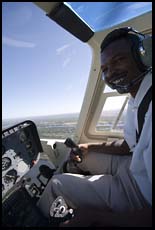

|
Learning to Fly Helicoptersby Philip Greenspun, ATP, CFI-H; July 2003, updated March 2009 |

|
This site contains the following primary resources for helicopter instruction:
FAR 91.119 says "Except when necessary for takeoff or landing, no person may operate an aircraft below the following altitudes..." and it turns out to be illegal to fly an airplane less than 1000' above the rooftops of a city (i.e., about 1200' above the ground) or 500' from any person, vessel, vehicle, or structure in the countryside (i.e., at least 500' above the ground). This is a much closer look than you would get in a commercial airliner, but it isn't all that close. FAR 91.119(d) says "Helicopters may be operated at less than the minimums prescribed in paragraph (b) or (c) of this section if the operation is conducted without hazard to persons or property on the surface." As long as the helicopter could autorotate to a tennis court, road, or field in the event of an engine failure, the pilot can fly much lower than in an airplane. This, combined with the view through the bubble, is what makes helicopters so great for sightseeing.
Getting a private helicopter license takes about 55 hours of in-air training, which translates to at least 30 days of hard work, usually spread out over at least 60 to 90 calendar days. The total cost should be well under $15,000, i.e., a lot less than a new S.U.V. and it will leave you with a much greater sense of accomplishment (though of course the average yuppie would apparently much rather have the S.U.V.). A brand-new four-seat Robinson R44 helicopter costs around $300,000 and can be easily shared by three or four owners.
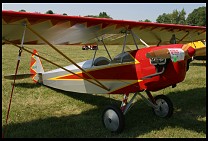 The FAA requires that you have at least 40 hours of helicopter time
before they'll give you a Private certificate. In practice most
students take closer to 60 hours. New pilots have to learn all the rules and
regulations, how to read charts and understand airspace, how to talk on
the radio, how to navigate when on a cross-country flight, and
how to fly a helicopter.
The FAA requires that you have at least 40 hours of helicopter time
before they'll give you a Private certificate. In practice most
students take closer to 60 hours. New pilots have to learn all the rules and
regulations, how to read charts and understand airspace, how to talk on
the radio, how to navigate when on a cross-country flight, and
how to fly a helicopter.
If you are already a certificated airplane pilot you already have all of the required skills except knowing how to fly a helicopter. The FAA relaxes the flight time requirement to 30 hours and in practice many students are able to pass their checkride after 40 hours.
Unless you're completely fearless and/or stupid, the prospect of hurtling towards the ground at a lethal rate of speed in an unfamiliar machine is frightening. Yet this is a required maneuver when landing any aircraft. Fear makes it harder to learn. Better to conquer your fear and get comfortable in the air in a $80/hour rented airplane than in a $229/hour rented helicopter.
If in the long run you want to be able to fly both airplanes and helicopters, start with airplanes now. If, on the other hand, you have no interest in airplanes, start with and stick with helicopters.
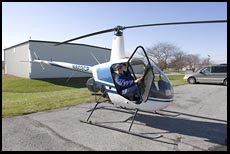 At most flight schools, you'll start training in a Robinson R22 (full review), designed in the 1970s by
Frank Robinson for folks who want to commute from their country homes
in the woods to their car dealerships, hospitals, or law offices in
the city. The R22 cruises fast and everything in the machine is
designed to be as simple, lightweight, and maintenance-free as
possible. It is truly the perfect helicopter except for one small
problem: the market Robinson designed it for does not exist. It
turned out that the haute bourgeoisie preferred to sit in
traffic and melt the pavement underneath their SUVs rather than take
responsibility for learning to operate a helicopter safely.
At most flight schools, you'll start training in a Robinson R22 (full review), designed in the 1970s by
Frank Robinson for folks who want to commute from their country homes
in the woods to their car dealerships, hospitals, or law offices in
the city. The R22 cruises fast and everything in the machine is
designed to be as simple, lightweight, and maintenance-free as
possible. It is truly the perfect helicopter except for one small
problem: the market Robinson designed it for does not exist. It
turned out that the haute bourgeoisie preferred to sit in
traffic and melt the pavement underneath their SUVs rather than take
responsibility for learning to operate a helicopter safely.
Flight schools, however, were quick to notice that the R22 was the world's cheapest helicopter to operate and began snapping them up. This proved to be a problem because Frank Robinson never designed the R22 for training and probably would have relaxed the high cruise speed requirement and put in a higher inertia rotor system to allow more time to react to student mistake during simulated engine failures. A friend of the author who has 6000+ hours and is a superb turbine helicopter pilot says that he is afraid to teach in the R22 and it was only luck that saved him from an accident because he just isn't good/quick enough to take the correct actions in the event of a student mistake. He is still willing to teach in the Robinson R44, however, where everything happens a lot slower due to the higher inertia in the heavier rotor.
Filled to half of its fuel capacity, the R22 is barely capable of hovering with 400 lbs. of pilot and instructor on board. If you're a typical American, now is the time to start your diet. My brother the M.D. says "If you want to lose weight, don't eat anything a caveman wouldn't have eaten. Meat and fish are okay. Fruits, berries, and vegetables that you could pick up off the ground or out of a tree are okay. Potatoes and grain are not okay. The human animal hasn't had time to evolve to deal with these products of the agricultural revolution." If you're too fat, you'll have to learn in a Robinson R44, for which the typical flight school charges a 50-100% premium.
Old school helicopter pilots will scoff at the R22 for a variety of reasons, including the low inertia rotor system, but there is no low-cost alternative. Schweizer, for example, which bought the old Hughes design, manufactures a comparative handful of piston-engine helicopters each year. Schweizer was purchased by Sikorsky and concentrates on rapid prototyping for the U.S. military. If Schweizer were to cease producing and supporting civilian helicopters it would probably result in a revenue boost for Sikorsky because the people and workshops could be transferred to military contracts. What does the U.S. Army use? The Bell Jet Ranger, which has similar rotor inertia to a Robinson R44. What about the quadrupled acquisition cost and doubled fuel burn? Nothing is too expensive for the taxpayers...
In my experience the four-seat Robinson R44 is the best compromise for a trainer. The extra power from having two empty seats makes it easy to recover from mistakes. You can learn hovering at 10' above the ground instead of 3', which results in a lot more room for error and less terror for the student. Autorotations in the R44 are much easier and the rotor RPM doesn't rush to overspeed or decay as fast. Hover autorotations in the R44 are slow enough that you can just about reach into the back seat for a drink of soda between the time that you roll off the throttle and need to pull up on the collective. Frank Robinson has been trying for several years to convince flight schools to use the R44 instead of the R22, but the economics don't work out. It is cheaper to crash the occasional old R22 than to equip a school with new R44s. Pathfinder Insurance, a Robinson-affiliated company, won't insure anyone to instruct in the R44 unless he or she has 500 hours of total rotorcraft time, so basically there would be no way to staff an all-R44 school. A growing number of foreign militaries are adopting the R44 as their primary trainer.
[East Coast Aero Club, the school where I teach, conducted an experiment with trainer pricing. We set the price of the R44 at a 50 percent premium over the R22, which made us the cheapest place in the world to rent an R44. We were charging 66 percent less than the cost of an R44 in Europe and 30 or 40 percent less than what other U.S. flight schools were charging. What was the result? Most students preferred to save $100 per hour and tolerate the additional risk of training in the R22.]
Look for a school with at least two training helicopters and two instructors. It is also a plus if the school has an on-staff FAA Designated Examiner. Otherwise you might have trouble getting an appointment to take your checkride. I have prepared a separate page with a list of recommended helicopter flight schools.
Given that you don't know how to fly, how do you evaluate an instructor? The best instructors are relaxed and comfortable even as the student makes a lot of mistakes. The best instructors are able to talk a student through a maneuver rather than putting their hands on the controls and "demonstrating". Once you've learned how to hold a hover and fly straight-and-level, take at least one lesson with each instructor at your school and then pick the one whose style suits you best. You'll probably learn at least 50 percent faster with an excellent instructor compared to an average instructor.
As a lower-time instructor myself, it pains me to say this, but I think that the best instructors with whom I have flown had at least 800 hours [I wrote that sentence some years ago; now I have over 1350 hours]. The low-time guys were often nervous and took the controls too readily. I have flown with one or two 10,000-hour instructors who were not so great; they could do amazing things with the helicopter but they weren't good at explaining to another person how to do those amazing things.
One strategy that you might pursue is to find a lower-time instructor who is a good explainer for the lower-risk maneuvers and then do the more challenging maneuvers with a high-time instructor. Maneuvers that demand a higher level of skill from the instructor include 180-degree autorotations, slope operations, throttle chops, and hover autorotations over anything other than a smooth paved surface.
 Because so many students have crashed R22s there are a bunch of special
legal requirements associated with the aircraft. You aren't allowed to
get into the machine at all until you've received and logged ground
instruction.
Because so many students have crashed R22s there are a bunch of special
legal requirements associated with the aircraft. You aren't allowed to
get into the machine at all until you've received and logged ground
instruction.
The ground lesson is partly about energy management in the event of an engine failure and partly about not getting the helicopter into unusual attitudes.
As with airplanes, much of the key to safety in a helicopter is energy management. In an airplane you have potential energy (altitude) and kinetic energy (forward speed) that can be traded off against each other to bring the airplane down gently in the event of an engine failure or ordinary landing. The helicopter has three kinds of energy: potential (altitude), kinetic (forward speed), and angular momentum (blade speed).
In an airplane you can make decisions about trading forms of energy very late in the day. For example, if you pull the stick all the way back at 6000' above the ground you will gradually slow down and eventually stall and perhaps enter a spin. With many airplanes you could spin nearly all the way to the ground before applying forward stick and opposite rudder to get back to a normal flight condition. All without an engine.
In a helicopter, by contrast, if the blades spin down more than 10-15% from their normal velocity, there is no way to convert potential or kinetic energy into spinning such that the helicopter will start to fly again. If you can't restart your engine, therefore, your helicopter can very quickly become a rock.
In a turbine-powered helicopter like a Bell 206 JetRangers the blades are heavy and the blades won't slow down for several seconds after an engine failure. In the flyweight Robinson, however, after an engine failure you have no more than 1.2 seconds to take exactly the right actions or the helicopter cannot be recovered.
What if you do take all the right actions? Suppose that you're up at 4000' and the engine quits. You lower the collective pitch (lever on your left) immediately to flatten the blades and allow them to be driven by the wind through which the helicopter is now falling at 2000 feet-per-minute. You adjust the cyclic (stick in front of you) for about 65 knots of forward speed. You aim for a landing zone. The good news is that you don't need a very large one but the bad news is that the glide ratio is between 2:1 and 4:1 instead of an airplane's 10:1 and therefore you don't have as large an area from which to choose. As you get within about 50' from the ground you pull back the cyclic to flare the helicopter and shed most of the forward speed. Just as in an airplane this flare also arrests most of the vertical speed. At the second to last moment you stop flaring and return the helicopter to being parallel to the ground. Ideally at this point you are hovering 5' or so above a soccer field and the blades are still spinning. Finally you raise the collective as the helicopter falls, using the stored energy in the blades against the force of gravity. You land gently on the skids. (In practice the cyclic flare is more important than the "hovering autorotation" at the end; a lot of people walk away from helicopter engine failures if they get the cyclic flare right but can't manage to pull the collective smoothly at the last moment.)
This all sounds good until you look at the "deadman's curve", known to the FAA as the "height-velocity diagram". The marketing literature for helicopters says "if the engine fails, you can autorotate down to a smooth landing." The owner's manual, however, contains a little chart of flight conditions from which it is impossible to land without at least bending the helicopter. It is safe to fly low. It is safe to fly slow. It is not safe to fly low (below 500') and slow at the same time. Unfortunately these conditions are the very ones in which nearly all helicopters seem to operate at least for brief periods. Suppose that you're landing in a field surrounded by trees and power lines. If you came screaming in at 65 knots you'd always have enough kinetic energy to do a nice autorotation, flare, and touchdown. At 65 knots, however, you probably wouldn't be able to hold the steep angle necessary to get into the field without hitting trees. At 65 knots you wouldn't have a lot of time to study the obstacles and the field before committing to a landing. How are you likely to do it? Low and slow!
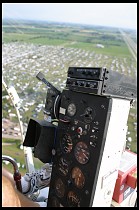 Before you get into the air you'll probably spend about half an hour
on a preflight inspection of the helicopter. With most airplanes most
of the critical pieces are hidden underneath bodywork and not accessible
except to a mechanic during an oil change or 100-hour inspection. With
the Robinson R22 the engine is mostly flapping in the breeze and what is
hidden can easily be accessed via a flip-up door.
Before you get into the air you'll probably spend about half an hour
on a preflight inspection of the helicopter. With most airplanes most
of the critical pieces are hidden underneath bodywork and not accessible
except to a mechanic during an oil change or 100-hour inspection. With
the Robinson R22 the engine is mostly flapping in the breeze and what is
hidden can easily be accessed via a flip-up door.
If the weather is nice you'll probably remove the doors. This ensures that you'll be nice and cool inside the machine. In theory you could look straight down while in flight and scare yourself but in practice your attention will be focussed on looking out the front and trying to hold the machine in a fixed attitude relative to the horizon. So don't hesitate to fly your very first lesson with the doors off. When the doors are off, it is good practice to take everything out of your pockets and put them in the baggage compartment underneath the seats. You don't want loose items getting sucked out of the helicopter and contacting the tail rotor, the fastest-rotating and most fragile part of the whole machine.
Sadly, a big part of your first lesson will be practicing the most difficult helicopter maneuver: hovering. Hardly anyone is able to become proficient at hovering in less than 5 or 6 hours of flight training. Every one of those hours is exhausting. Much of the time is frustrating.
More: the lesson plan that I use
What do folks who've never flown an aircraft before do? Sit there fat and happy while the attitude drifts a bit. Eventually the drift gets to the point that the helicopter is pointing 180 degrees from where it started or 45 degrees nose-up or 45 degrees nose-down and heading straight for the trees. At this point even a brand new pilot senses that something is amiss and it is time for a flight control input. A big one. The 45-degree nose-down attitude then turns into a 45-degree nose-up attitude.
The key in flying successfully and smoothly is to watch for small attitude changes and compensate with small control inputs. This is easier said than done, of course, and the instrument-rated airplane pilots have a big edge.
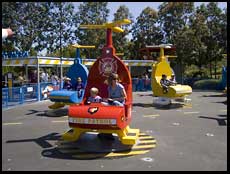 A big selling point of helicopters is that you can land in your
backyard. Where then would be the best place to learn to hover? An
airport with a 12,000' runway and a 7,500' crosswind runway. You want a
lot of open space where you're guaranteed not to hit anything. You want
somewhere that neighbors won't complain about the noise. You want
somewhere with long sight lines to the horizon so that you won't
concentrate your gaze in too close. You want somewhere that you can get
fuel when you run out. All roads lead to the big airport! Generally
the tower and ground controllers will give you permission to practice
hovering on whichever runway isn't be used that day and/or over a
seldom-used taxiway.
A big selling point of helicopters is that you can land in your
backyard. Where then would be the best place to learn to hover? An
airport with a 12,000' runway and a 7,500' crosswind runway. You want a
lot of open space where you're guaranteed not to hit anything. You want
somewhere that neighbors won't complain about the noise. You want
somewhere with long sight lines to the horizon so that you won't
concentrate your gaze in too close. You want somewhere that you can get
fuel when you run out. All roads lead to the big airport! Generally
the tower and ground controllers will give you permission to practice
hovering on whichever runway isn't be used that day and/or over a
seldom-used taxiway.
Most instructors will start by giving you one control at a time. You take the antitorque pedals and they handle the cyclic and collective pitch. You practice pedal turns. Then you take the collective while the instructor controls the cyclic and pedals. You go up, you go down. Maybe you land. Then you take the cyclic and the instructor takes the other controls and ... 1 second later the helicopter is oscillating like crazy and you hear "I have the controls" in your headset. Any good instructor will alert you to the fact that you need to be very light on the controls: "you fly with pressures, not movements." The instructor will also tell you that there is a bit of lag between the time that you put in a control input and the time that the helicopter reacts. What most instructors won't tell you is how to deal with these facts.
Here are a few tips for handling the cyclic, which controls forward/back and left/right movement of the helicopter:
I like to take a student up to 3000' AGL and have him or her glide down to 500' AGL before adding power and climbing back up to 3000' again. In other words, the student practices the entry and glide repeatedly without being close to the ground and without worrying about the flare or power recovery. After perfecting these parts of an autorotation, the student comes back for another lesson and starts doing flares and power recoveries.
For 180-degree autorotations, the typical problem is that the student lets the nose drop in the right turn. Now the airspeed builds up and the descent rate correspondingly increases, which increase the rotor RPM. A low-time instructor is going to have his hands full recovering an R22 from this mournful situation. Best to start at 3000' again. Have the student enter straight-ahead and establish a 65-knot 100 percent RPM autorotation, with a slightly raised collective to hold the RPMs at 100 percent. At this point the student can start some left and right turns, taking care not to let the pitch attitude, and therefore airspeed, change. The RPM will rise in the turn, but only to about 104 percent, still well within the yellow, and a collective adjustment is not required.
The most important parts of a hover auto are stopping the yaw (pedal) and stopping the drift (cyclic). If a helicopter falls from 2' and the collective isn't touched, there shouldn't be any damage as long as the skids don't have to absorb a big yawing or drifting moment. Remember that the blades still have some pitch on them and are providing some lift.
Start out with the helicopter just 6" to 1' off the ground. Ignore the collective. Work on using the pedals and cyclic so that the helicopter is neither yawing nor drifting when it hits the pavement. When you've mastered these controls, start doing hover autos from higher up and add some collective input towards the bottom.
Instructors: There is little value in teaching students to raise the collective at the bottom of a hover auto. Concentrate on the pedal and cyclic work, which do not come naturally for most pilots. Nobody who is in a helicopter that is falling toward the ground needs a CFI to tell them to pull up on the collective. Remember that pavement is not as forgiving of small problems with hover autos compared to grass, but big yaw or drift when hitting grass is more likely to result in a dynamic rollover than the same sloppiness on pavement.
Don't go anywhere at night that you haven't been to a lot of times during the daytime. The only exception to this rule would be when flying from airport to airport, in which case you should stay 2000' AGL until you have visually identified the destination airport. Establish high personal weather minimums for night flying, even with an instructor. I do not like to leave the airport traffic pattern unless the visibility is at least 10 miles.
Helicopters, by contrast, are seldom equipped and almost never certified for IMC. If you get your instrument rating at 120 hours, for example, and then try to get the CFII at 250 hours, you'll probably find that your instrument proficiency has deteriorated dramatically. If, on the other hand, you get your helicopter instrument rating at 249 hours and your CFII-H at 250 hours, you only need to get sharp once. When you finally do get that medevac job at 2000 hours and need to get your instrument currency back, of course you'll have to build your instrument proficiency again.
Instrument training in an airplane will save you a lot of money and the skills transfer very nicely. As a moderately experienced airplane instrument pilot and 200-hour helicopter pilot, I was able to hop into a Robinson R44, put the hood on, and fly several flawless ILS approaches.
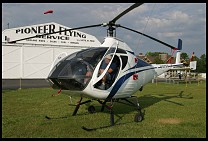 The FAA tries to make it difficult to crash an airplane. They keep
trees, towers, buildings, and powerlines away from airports and runways.
Airplanes are stable. If the pilot takes his hands off the controls,
the plane will fly itself for 30 seconds (or 3 hours if typically
equipped with an autopilot). Nonetheless, pilots of small aircraft
managed to crash roughly 7 times in every 100,000 hours; 1.4 out of
those 7 times, the accident was fatal.
The FAA tries to make it difficult to crash an airplane. They keep
trees, towers, buildings, and powerlines away from airports and runways.
Airplanes are stable. If the pilot takes his hands off the controls,
the plane will fly itself for 30 seconds (or 3 hours if typically
equipped with an autopilot). Nonetheless, pilots of small aircraft
managed to crash roughly 7 times in every 100,000 hours; 1.4 out of
those 7 times, the accident was fatal.
People fly helicopters into friends' backyards, onto highways on rainy nights after car accidents, onto rooftop helipads, and with air conditioners hanging underneath. Helicopters are unstable and very few are equipped with autopilots. You'd expect helicopters to be vastly more dangerous than airplanes. They are and they aren't. Big jet-powered helicopters are safer than small airplanes, but not by the huge factor that big jet-powered airplanes are safer. The jet-powered helicopters suffer 4 accidents per 100,000 hours, 1 of which will be fatal. Piston-powered helicopters, which these days means "Robinson", suffer 13-20 accidents per year, with roughly 2 of those accidents being fatal.
There are a lot of straightforward ways to improve helicopter safety, some recommended by NASA and some already implemented in Europe and by oil companies:
The good news about helicopter safety is that it is largely under your control as the pilot. If you want to cruise along for 25 miles skimming the ground 100' above obstacles and then land in your friend's backyard, which is surrounded by powerlines and trees, you are asking for trouble. If you take off and land at public airports and fly 500' above the terrain your risk is probably not that different from doing the same trip in a small airplane. Experience with a particular aircraft or "time in type" is a huge contributor to safety; nothing stops a pilot from bringing an instructor along for the first 100 hours in a new aircraft.
As with other kinds of flying, safety in a helicopter depends to a large extent on the ratio between a pilot's level of confidence and level of skill.
More:
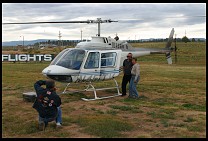 Is it your dream to fly an expensive jet-powered helicopter without
paying for the hours? Thank your neighbors for driving SUVs. Every
year the oil industry goes farther offshore to get oil. The only way to
get to an offshore platform is by helicopter and thus every year there
are more jobs for helicopter pilots. See our helicopter training page for
more information.
Is it your dream to fly an expensive jet-powered helicopter without
paying for the hours? Thank your neighbors for driving SUVs. Every
year the oil industry goes farther offshore to get oil. The only way to
get to an offshore platform is by helicopter and thus every year there
are more jobs for helicopter pilots. See our helicopter training page for
more information.
If you're quasi-rich, the best helicopter is a fuel-injected Robinson R44 Raven II with air conditioning. If you're poor, you probably don't want a kit helicopter. What you want is a 4- or 5-way partnership in a Robinson R22. A small helicopter isn't like an airplane. You usually take it out only for an hour or two on a local trip, which makes it very easy to share and scheduling conflicts among partners are unlikely. Splitting insurance and hangar costs 4 or 5 ways brings down the total cost of ownership and flying to perhaps $10,000 per year.
I have purchased several factory-new R44s between 2006 and the present from Andres Kerllenevich at Old City Helicopters. Another good source for new Robinsons is Candise Tu at Civic Helicopters in Carlsbad, California. It is best to buy from a local dealer when possible because the labor warranty is valid only at the dealer where you purchased the ship.
 Is there any hope for improvements in light helicopters? Robinson was
started in 1973 and shipped the first production R22 in 1979. The
machine has been improved, of course, as 4000 examples were cranked out.
An R22 loses power at higher altitudes because its engine is not
turbocharged. An R22 can get you killed if you don't manage the
fuel/air mixture or carburetor heat properly (i.e., the engine is not
fuel-injected)--according to a
2000 NASA study, "The primary reason for loss of engine power was
directly traced by the NTSB to fuel/air mixture problems, which
accounted for no less than 985 accidents." An R22 can't be flown in
instrument meteorological conditions because, among other things, it
lacks an autopilot (helicopter autopilots cost $250,000+).
Is there any hope for improvements in light helicopters? Robinson was
started in 1973 and shipped the first production R22 in 1979. The
machine has been improved, of course, as 4000 examples were cranked out.
An R22 loses power at higher altitudes because its engine is not
turbocharged. An R22 can get you killed if you don't manage the
fuel/air mixture or carburetor heat properly (i.e., the engine is not
fuel-injected)--according to a
2000 NASA study, "The primary reason for loss of engine power was
directly traced by the NTSB to fuel/air mixture problems, which
accounted for no less than 985 accidents." An R22 can't be flown in
instrument meteorological conditions because, among other things, it
lacks an autopilot (helicopter autopilots cost $250,000+).
The fundamentals of range and payload can't be improved without an improvement in engine technology. For the R22, Robinson uses a Lycoming O-360 engine, a 50-year-old design that weighs close to 300 lbs and requires high-octane leaded Avgas. The Thielert/Centurion 1.7 engine used in European versions of the Diamond Star DA40 and all versions of the Diamond Twin DA42 seems to offer some promise. At 295 lbs., this adaptation of a Mercedes car diesel engine weighs about the same as the Lycoming O-360 but is more efficient in terms of power per pound of fuel consumed. Furthermore, the Thielert engine is simpler to operate (no carb heat or mixture control) and turbonormalized up to 12,000'. The net result of using an aerodiesel engine could be a helicopter with longer range and much better performance in the mountains. Sadly the current Thielert engine can't match the O-360 for peak power at sea level and therefore would not be capable of hovering at the same gross weight.
An autopilot is 95 percent software and computer power and 5 percent sensors and actuators. The latest Japanese mobile phones have more computing power than the autopilots in a lot of certified-for-IMC helicopters. You'd think therefore that there would be some hope of an inexpensive helicopter autopilot one day. Given the conservatism of the industry, the limited number of potential sales, and the Byzantine bureaucracy of the FAA, however, it is probably safe to say that it we'll reach the year 2020 before an inexpensive autopilot is available in a certified helicopter.
 If a northern winter is keeping you from building skills and/or you've
read Path
Between the Seas, consider a trip to www.helipan.com in Panama. I spent 9
days in Panama in February 2004 and managed to fly every day with
excellent instructors in well-maintained R22s. There is a refreshing
lack of restrictions of flying and landing helicopters within Panama.
You are welcome to fly low over the jungle, up rivers, land at
historical sites or in Indian villages. Fear of Islamic terrorism,
sadly, has resulted in a "2500' above or 2000' from" flight restriction
over the Panama Canal.
If a northern winter is keeping you from building skills and/or you've
read Path
Between the Seas, consider a trip to www.helipan.com in Panama. I spent 9
days in Panama in February 2004 and managed to fly every day with
excellent instructors in well-maintained R22s. There is a refreshing
lack of restrictions of flying and landing helicopters within Panama.
You are welcome to fly low over the jungle, up rivers, land at
historical sites or in Indian villages. Fear of Islamic terrorism,
sadly, has resulted in a "2500' above or 2000' from" flight restriction
over the Panama Canal.
Panama has a dry season from late December through April that they call "summer". Expect sunny, hot, windy weather, turbulence through the mountains, and waking up at 0500 if you want to find wind calm enough to solo. The rest of the year is the rainy season or "winter". Expect overcast skies, heat and stifling humidity, calm winds, and Biblical rains during the afternoon.

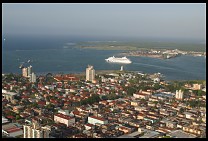
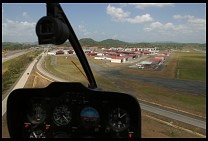

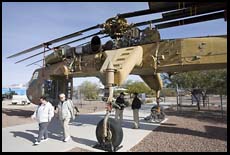 While reading the Robinson R22 Pilot's Guide (John Swan; ASA), a few
comparisons to airplanes came to mind. If a small part comes off of or
out of an airplane it might strike the tail and create an expensive dent
that will very likely have no perceivable effect on aerodynamics. If a
small part comes off of or out of a helicopter it might strike the tail
rotor, a very fragile component of the machine. You will readily
perceive the aerodynamic effect of the damaged tail rotor as you spin
down to your death.
While reading the Robinson R22 Pilot's Guide (John Swan; ASA), a few
comparisons to airplanes came to mind. If a small part comes off of or
out of an airplane it might strike the tail and create an expensive dent
that will very likely have no perceivable effect on aerodynamics. If a
small part comes off of or out of a helicopter it might strike the tail
rotor, a very fragile component of the machine. You will readily
perceive the aerodynamic effect of the damaged tail rotor as you spin
down to your death.
If you throw the battery and alternator out of your cheap little airplane while in flight your magneto-ignited piston engine still runs. Moreover, all of the gauges that you need to fly and land safely in clear weather conditions will still operate. If something bad happens to the electrical system in the R22 you lose the engine and rotor tachometers. You also presumably lose the engine speed governor. Your engine still runs but now you have to manually adjust engine speed without any information from the gauges. Swan refers to this as "a very dangerous flight condition" and, when it happened to me during the 200th hour of my flight training, while doing a 180-autorotation on the Big Island of Hawaii in preparation for my CFI-H checkride, it was indeed quite frightening.
Paid for 3 hours of tuition in a Schweizer / Hughes in the UK (Biggin Hill, near London).Great fun, but not cheap at 500 quid (800 dollars?), and this was a special offer.
Absolutely loved the experience.
Within a minute of starting up, I had control of one control, gradually moving up to all controls within about another minute or so!
Absolutely superb.
Instructor was rather dismissive of the R-22 and research at time seemed to show that the Hughes was safer.
But far too expensive to do in the UK, and the UK is far too busy.
Highlight was an hours flight around the South-East coast, Dover, Kent, seeing Southend and then back.
I did all the flying and observation while the (slightly inexperienced or very trusting) instructor worked out the heights required and what we had to avoid (prisons etc - they get nervous about low flying 'copters).
Great moment as a Gipsy Moth did aerobatics just to my left, and below me.
Great experience, only hope I get rich one day.
-- Rob Allright, November 25, 2003
If you haven't gotten your rotor license yet, you might want to check out www.kdhelicopters.com and see about possibly taking some lesson's with Kim Darst. She's one of the best helicopter pilot's in the U.S. If you want to know more check out http://women-in-aviation.com/cgi-bin/links/detail.cgi?ID=517 for her full biography. Happy hovering!!
-- Mike Valentin, March 28, 2004
Being a certified Canadian Commercial Helicopter pilot type-rated on both the RH22 and Bell 206, I'd just like to add my 2 cents:Helicopters (like any other aircraft) are only dangerous for those who fail to respect their parameters and the environment in which they fly. Helo pilots are trained to react quickly, knowing full well the capabilities and demands of their aircraft. (Something an airline pilot in a fixed-wing "heavy" near MGTOW will identify with around V1 speeds....) :D
If you're hoping for a 'turn your mind off/take a drive in the sky' experience, then yes, you're *definitely* headed for trouble in a helicopter. You *cannot* trim a helo in 3 axes and gaze idly out the windshield. (Not recommended, even if you do have an autopilot/co-pilot!) :)
An engine failure (and subsequent autorotation) is, however, far less stressful in a helicopter than an engine failure in a fixed-wing aircraft. Why? Your ability to trade vertical & horizontal speed against rotor rpm gives you a greater selection of landing places. No need for a long straight path with unobstructed glideslope! That tennis court! Or that parking lot! Maybe even that little field! Also, the lower final vertical & horizontal speeds associated with an autorotation assure you that if you even dent or roll the craft over when landing, you're better off than the fellow who stuffs his Piper Cherokee into the scenery at 60 knots. :)
(On a more flippant (but equally valid note): You'll also not have enough time to worry or doubt yourself. From "engine-failure!" to autorotation to "good stuff! perfect landing!" takes about 30 seconds in an R22, presuming an initial altitude of 1 000 feet AGL. You're sharp? you're alert? then you're alive. I don't know about you, but if my motor snuffed it, I'd want to be on the ground in one piece as soon as possible...) :D Okay, so now you know, helos are the greatest thing since the invention of the aerofoil. So why do so many pilots crash and burn? Well, the greatest danger with helicopters (like EVERY other craft) is not the craft itself. It's the pilot and the choices he makes/the environment he operates in.
If you're doing vertical reference flying (ie. flying with an external load) around powerlines in the fog when near max gross weight, then yes, your risk factor does goes up. Like everything else in life, all manoeuvres should be weighed for "risk vs. time of exposure".
That said, far too many pilots take this lightly and put themselves deliberately in harm's way. The vert. ref. pilot mentioned above has weighed the odds and has his thumb hovering on the winch release in case he needs to jettison the load. If only every pilot were so responsible.
With Wagner's "Ride Of The Valkyries" in their head, too many fly ridiculously low, with no justification whatsoever. They buzz crowds and be a nuisance (face it, most people see helos as blenders just waiting to puree unsuspecting bystanders.) The joyriding pilots perform low-G pushovers in teetering-rotor designs (like the Robinsons and nearly every Bell made) and encounter 'mast bumping'. They get themselves in vortex ring state by descending at the same speed as their downwash (therefore net lift = 0). And the list goes on. One of my long-ago instructors neglected to perform a proper pre-flight inspection and plowed in, taking the mechanic with him. Another took off at night in inclement weather up north and wasn't found for a year, and even then only by accident. (Needless to say, he wasn't alive.)
These were all men with experience. What did them in wasn't the machine per se, it was their lack of judgement. This is the true killer, no matter what you fly. (How many of you would scud run in a Gee Bee replica over unfamiliar terrain?)
I hope that those of you I've not bored to tears with this entry have got something out of it. :D
Should you have any questions/comments/feedback, feel free. :)
Keith Helwig.
-- Keith Helwig, August 12, 2004
I have recently started training to fly helicopter's using the R22. I have held a commercial fixed wing (light aircraft) in both NZ and Australia but both are lapsed some years now. The desire to fly helicopters has been a "disease" that has been with me since I was 4 years old (now 41). My fixed wing experience allowed me to concentrate more on actually flying the aircraft as opposed to trying to take in instruments, radio etc. Having said that there are several points against my fixed wing flying experience - there appears to be a less reliance on instruments than in fixed wing....I'm slowly learning not to cheat by setting attitude via instruments:) Is it good? Oooooooooh Yes - there is absolutely nothing like it. If you have a passion for fying then helicopters have to be the ultimate flying you can do. I enjoy the R22 - but then I have nothing to compare it to. Is it dangerous? Like any aircraft they certainly have the potential to be dangerous. Concentration required between flying fixed wing and rotary is huge - Fixed wing aircraft can be trimmed out in straight and level flight and (not advised) can be left to saunter off in the direction they are pointed with no hands (or very little) required from the pilot (well, on a calm day :)) - Helicopters require full pilot input at all times. Once the machine is live you need full concentration. Know everything about your machine - you can never know enough. Is it expensive? Well let me answer that with a question - does anyone have a spare kidney they could give me to sell off for flight hours :) We're paying around US$280 an hour in the R22. The Hughes 300 (Schweizer) is more expensive but by how much I don't know. In NZ we need to do 50 hours for PPL and I think it's another 100 hours(it may be 150 hours) for CPL. Because of the mountainous country here there is a certain number of mountain flying training required both in PPL and CPL.I'd like to exit on a light note and say that if you want to fly then fly a real aircraft and go helicopters.
-- Marc Angelo, June 21, 2005
After learning about some people who have flown their RotorWay helicopters on 5,000 mile trips, I decided to take my RotorWay on a cross cousntry trip of only 1,300 miles. I knew that from flying an R22 that I would definitely prefer flying the RotorWay over the R22 anytime, but was not at all sure how well and reliable mine would be on a long trip. I had added a Lowrance 2000C GPS to the RotorWay, and that, with its FADEC system, I found the trip to be easy, and the helicopter to be a stable and reliable platform. Many people had told me that they thought that flying a helicopter was very tiring, but I have to say that I was not very tired even when flying all day. In fact, it took only a light touch on the cyclic and collective and peddle inputs were minimal on the entire flight. My one maintenance item was after about 1,000 miles it was necessary to tighten the drive belts to the secondary, but outside of that the machine just flew uneventfully. On several legs where winds aloft showed tail winds available, I climbed to 3,500' and enjoyed 137 MPH ground speed according to the GPS. My conclusion is that cross country helicopter trips are not only a joy, but a great way to travel distances, and would encourage others to do so. And, though I have not taken really long trips, I anticipate trips in it of several thousand miles in the future.
-- Jim Rapier, November 2, 2005
I have owned both a R-22 and R-44 and have flown both on 10 to 20 day long trips my favorite being from San Diego to Alaska if any body would like to see pictures please e-mail me.
-- Todd Peters, September 13, 2011
The thing I found to be the biggest help is moving your head for every input of the controls. If you pull up on the collective move your head up. If you put a left pedal in turn your head left. I found this to be helpful with the lag created by not being hard attached to the flying wing. When flying an airplane your inputs happen as fast as you move the controls. With helicopters there is a momentary delay causing people to input more, and then having to over correct because of it. Then the whole thing repeats, the input lags the student adds more, and you end up chasing the aircraft all over the place. When you move your head it gives the sensation of instant change for the input. I call this ( flying with your head ). Fly the rotor, not the cockpit. Thanks for reading Mick O'Brien
-- Mick O'Brien, January 21, 2015
Amazing Group of Helicopters Landing https://youtu.be/qSQzAOPv5JU
-- J Olesen, April 29, 2015